Menus
- Track test: An R1 or Nothing ?
- Queen of beauty, the R1 has won over many bikers with its plastic and dynamic qualities. In 14 years of existence it has already undergone 7 evolutions, the last having above all for the purpose of adding traction control. Back to the story of a (fallen?) Icon ….
- 1998: birth of a star
- 2000: update
- 2002: Injection and “stealth” look
- 2004: The state of grace
- 2007: Electronics take power ….
- 2009 2011: the big bang !
- Discovery
- In the saddle !
- Contact
- On track !
- Braking
- Conclusion
Track test: An R1 or Nothing ?
Queen of beauty, the R1 has won over many bikers with its plastic and dynamic qualities. In 14 years of existence it has already undergone 7 evolutions, the last having above all for the purpose of adding traction control. Back to the story of a (fallen?) Icon ….
1998: birth of a star
That year, Yamaha broke with the versatile sports Thunderace and Thundercat. The R1 is an uncompromising motorcycle, which revives a long tradition of breathtakingly beautiful sports cars. Fine, stretched lines appeared in the 1970s on the 250 DS7 and 350 R5. The R1 illustrates " the spirit of Kando "Dear to the brand, which highlights the deep satisfaction and enthusiasm of owning a beautiful object…. Undoubtedly, the R1 has the beauty of efficiency and a pedigree that impresses: 150 horsepower, 200 kilos with full tank and 278 km / h in peak, all in a template of 600 at the time. The fittings are at the top: inverted fork, 4-piston monobloc calipers (more rigid), 5-valve cylinder head, Exup system on the exhaust and carbon silencer (which also ages quite badly). The cycle part is demanding and lively. The steering damper is not standard, but beware of the handlebars !
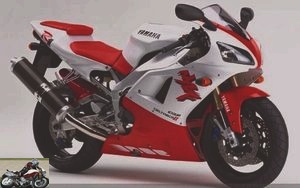
2000: update
Barely 2 years and already an upgrade. Aesthetically, the spirit remains. The silencer adopts a titanium envelope. The suspensions are worked on, the selection improved and the carburetor engine is brought up to euro1 standards. Despite the evolutions, the R1 keeps a very muscular piloting…. and falls on a bone: the 1000 GSXR: 10 more horses and 10 better terminals !
2002: Injection and “stealth” look
The lines are stretched and yet the R1 softens its character. Aerodynamics lose and the top speed too (it drops to 274 km / h). The engine receives an injection and gains 2 hp in the operation. It also becomes less brutal. It now passes the Euro2 standard. The 3rd generation of the Delta box chassis is even more rigid. The swingarm is also new and the assembly is now painted black. If the driving position is still tilted forward, the R1 becomes easier to ride, but still retains a tendency to steer. Despite performance clearly down compared to the “Gex”, the R1 is popular and sells well. It’s even the best selling hypersport in 2002.

2004: The state of grace
The new design is a masterpiece! This Japanese girl has the sultry beauty of an Italian.

The 2004 vintage is entirely new with an engine with much more supercarized ribs to go higher in speed and gain power (77 X 53.6 against 74 X 58 previously). The power is supplied by a double butterfly injection. Yamaha announces 172 hp at 12,500 rpm in static, a jump of 20 horses! In addition, the dynamic air intake would boost its engine by an additional 8 hp at maximum speed according to the manufacturer…. The frame is also new, as is the swingarm now reinforced from below to make room for the exhaust pipes. The 2 silencers are now located under the saddle. The beautiful takes 3 kg by the way and displays 204 kg all full facts. Note the adoption of a steering damper. The fork goes from 41 to 43 mm while the braking is improved: the discs go from 298 to 320 mm with radially mounted calipers.
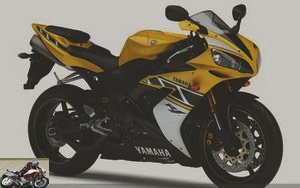
In 2006, Yamaha did not take the risk of changing a winning recipe. The evolution is discreet: longer swingarm, improved distribution of the stiffness of the frame for better handling. Engine side we gain 3 horsepower (175 static). The dashboard receives a chrono function.
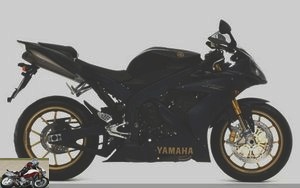
For the more fortunate, an SP version of the Yamaha R1 makes its appearance with Ohlins suspensions, forged Marchesini rims, specific paint. It is offered at around € 1,500 more ….
2007: Electronics take power ….
If aesthetically the changes are relatively contained, we note on the other hand the arrival of an electronic accelerator and a variable length intake supposed to make the engine more usable. The evolution towards a model easier to pilot is clearly confirmed. The techno-parade begins.


2009 2011: the big bang !
So here we are at the version we are testing. With this model, Yamaha is riding the exploits of Valentino Rossi in GP and those of Ben Spies in SBK. In addition to a major aesthetic makeover, the current R1 is characterized by its stalled engine " cross plane ". This means that the crankshaft pins are offset 90 ° and not 180 ° as is customary on an in-line four cylinder..
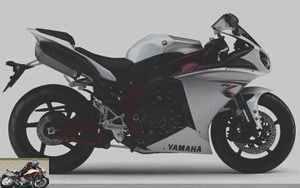
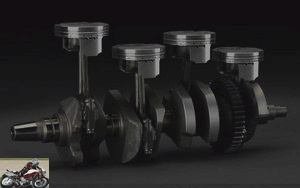
Concretely, this in-line engine behaves like a V4 open at 90 °. The idea is inspired by the experience gained in GP. It has in fact been observed that such an engine delivers its instantaneous torque less jerky, which promotes traction. Will this be enough to make this version a champion of the slopes? Let’s start with a little tour of the owner ….
Discovery
This Yamaha does not betray its lineage. It is neat, well finished and very well equipped. Aesthetically, the 2004 version seemed more airy and more prominent, but that is still a matter of taste. The look has lost its aggressiveness (it’s fishy …) and plastics have made an abundant appearance ….
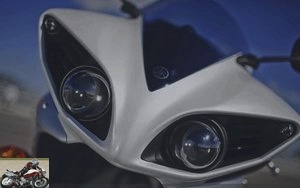
However, the beautiful has really lost the line because she now weighs 215 kg all full on the scale, which makes her the heaviest of modern sports cars! Technology is good but it has to be paid for, on the scale as well as at the bottom of the bill ….
In the saddle !
If the first R1 impressed with its small size for the time, this version now seems bulky, especially against an Aprilia RSV4 for example…. The position is not the most extreme, but does not offer the comfort of a GSXR whose versatility is still the benchmark despite the years that go by. The dashboard is both simple and nicely designed, as is the tradition at Yamaha where you are used to paying attention to detail. But it is not the most readable and does not have a handlebar control. In addition to a gear indicator engaged and a chrono function, there is also a throttle opening graph which is not necessarily of great use. The meter is digital.
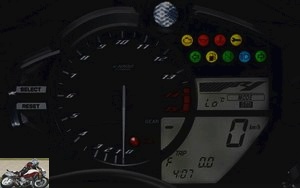
Contact
As soon as you start the engine you can tell that something "abnormal" is going on. This four-cylinder has a non-Catholic sound…. a noise from V4 quite stupidly. Take off is smooth, but the flexibility has lost some of the smoothness of the in-line 4 cylinders of the previous version. On the other hand, obviously, it tows well from mid-revs.
On track !
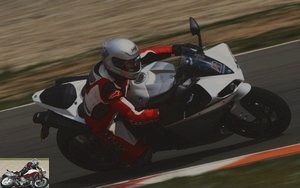
This is essentially where we developed the R1, because its pedigree and high technology should be highlighted more than on bumpy departmental roads and in the 100 hp version. Especially since it is already difficult to judge the aptitudes of such a racing car for an ordinary driver…. So as long as you do it, as long as it is in good conditions.
From the first laps of the wheels on the track, we appreciate the good availability of the engine at mid-speed and the quality of the chassis components. Brakes, suspensions, swingarm frame are undoubtedly flawless. It does not wiggle, nothing is soft, everything is precise as you would expect from a machine at this price. The traction is excellent and thanks to the engine timing we can put the throttle back on without fear of an escape. It is particularly reassuring when the grip is precarious.
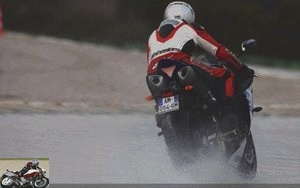
You can then use the 3 maps available on the handlebars. While one of the modes actually clamps the engine and can be used in the rain, the other two are characterized by a different engine response to throttle opening. In fact, thanks to the electronic accelerator you simply play on the ratio between the opening of the throttle grip and the opening angle of the throttles. It’s more or less brutal, but in these last two cases, we always have the same maximum power. Only the dosage is more or less delicate. The less experienced pilots will have every interest in opting for the softer mode of the two.
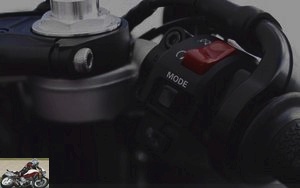
But thanks to its cross plane setting, the R1 does not throw you off. So much so that one wonders if traction control is really what should be added to this bike to make it even more convincing. ?

Because if the machine seems bulky, it also seems relatively clumsy in the sequences.

The fault is undoubtedly a slight overweight, but also the distribution of the masses. With its high-placed exhausts, the R1 displays significant polar inertia which penalizes its liveliness during transient phases (entering a curve, recovery, pif-paf….).

Next to it an Aprilia looks like a real toy! yet on the scale the Aprilia weighs only 2 or 3 kilos less than the R1. But these masses much more centered make it Ô how much more lively! ! ! Likewise, the Aprilia V4 is more angry and exciting than the Japanese “fake V4”. In pure power the RSV4 is not one step ahead (a good ten hp on the bench all the same), but beyond 9 / 10,000 rpm, the Italian widens the gap and it feels … . The Yam pulls well, but doesn’t really pull. What to say in front of a BMW S 1000 RR? At full power, the R1 shows a deficit largely exceeding 30 hp on the bench. In the straights, the mass is said…. The BMW passes it with more than 15 km / h better! Yet aerodynamically Yamaha has taken things in hand. In pure speed the R1 is efficient given its modest power for the category, it also offers very acceptable protection..
Braking
Richly equipped, the R1 has 6-piston monobloc calipers with radial mounting. It’s powerful, dosable, efficient, flawless. The 2 floating discs of 310 mm do not flinch despite the kilos. In this area the GSXR 1000 2010 cannot fight. Despite all the on-board technology, the R1 does not offer a sports ABS system. Pity !

Conclusion
Regularly upgraded the R1 accuses the weight of years and the weight quite short in the face of European competition in particular. The technological developments made are certainly important, but they remind us that when it comes to sports, one of the fundamentals remains weight and its distribution. The other is power and in this area too the R1 is lagging behind. Hence the disappointment to see a 2012 version arrive which almost ultimately offers only additional traction control.

We have not tried it yet, but our complaints were not in that direction, quite the contrary. Thanks to the crossplane technology, the R1 was already claiming good traction and ease of operation of its engine. We would have preferred the eternal good recipe: more horses and less pounds. A low exhaust also to reduce the inertia of the motorcycle in transient phases. Anyway, something in the style of what the competitors have done to make the bike more fun and easier on the track. Because all this in-car technology comes at a price that puts the R1 above a more versatile GSXR and CBR, and it’s more expensive than the much more modern and powerful new kawasaki ZX 10 R. For a very close price you can also treat yourself to an Aprilia RSV4 or even a BMW and there is no picture as they say…. So Mr. Yamaha, even if this R1 is superbly well finished, we would like it to modernize a bit ….
This is all the more surprising given that its technological content is enormous, but that faced with a very classic GSXR "which has nothing" the Yamaha does not really make the difference for use on the road or on the track, except on the road. braking undoubtedly. But note that Suzuki has heard the criticism by equipping its 2012 model with Brembo calipers, while Yamaha seems to be turning a deaf ear ….
Strong points
- The finish and build quality
- the ease of the engine
- Strong technological content.
- The 2011 promo with Akra pot and seat cowl for € 1 more
- Finishes
Weak points
- The high weight
- Performance in decline
- The price / performance ratio
Competitors: Aprilia RSV4, BMW S1000RR, Ducati 1198, Honda CBR1000RR, Kawasaki ZX10R, MV Agusta F4, Suzuki GSXR-1000
The technical sheet of the Yamaha R1
Prices: R1 2012 € 15,999
R1 2011 promo € 14999 titanium akra pot + seat cowl + € 1
Related articles
-
Suzuki GSX-R 600 motorcycle test
Little Queen Revamped this year, the 600 GSXR follows in the footsteps of its big sister 750 cm3 from which it borrows the dress and even all the…
-
200 hp at 13,500 rpm, 112 N.m at 11,500 rpm, 199 kilos with full fuel, from € 18,499 Is the Crossplane engine an advantage in road use ? Even if the…
-
Suzuki GSX-R 1000 motorcycle test
A friend who wants you well First appearing in 2000, the GSXR 1000 will quickly establish itself as a sporting stallion for a long time. But in the face…
-
Suzuki GSX-R 750 motorcycle test
Out of category champion A true modern icon of motorcycling sport, the 750 GSXR pursues its solo career, without however ever visiting the paddocks or…
-
Roadster Sport-Heritage Fasters Sons Following on from the XSR 700, Yamaha today unveils its new Sport-Heritage XSR 900 roadster in dynamic fashion….
-
Two-Temperaments ! At the end of the 1970s, when motorcycles with large-capacity multicylinder engines weighing a dead donkey have been in vogue for a…
-
Double-dealing ! Long announced, the Yamaha YZF-R3 Yamaha is finally out of the woods and completes the sport range of the Japanese manufacturer, halfway…
-
2012 Kawasaki ER-6n motorcycle test
New test: Kawasaki ER 6N: Sparkling with mischief ! Appeared in 2006 and restyled in 2009, the ER6 N gets a new facelift that makes it even sexier,…
-
Kawasaki ZX10R motorcycle test
The motorcycle division of the giant Kawasaki industry, is only a drop in the sea, but that does not prevent it from being a major player in the world of…
-
Honda CRF 250 L motorcycle test
A little trail that sparkles The great Escape You don’t like small cars? So be sure to read this article! Because after discovering this new Honda, you…